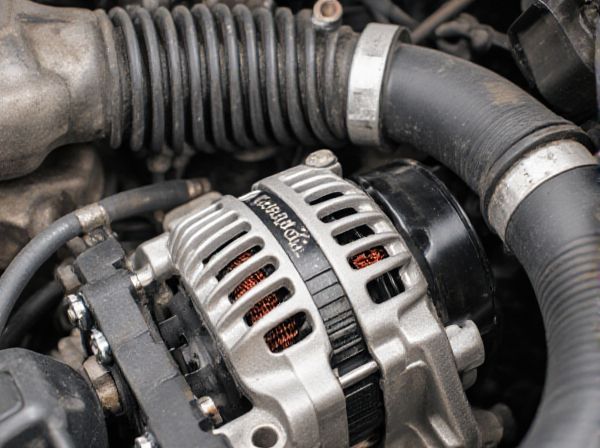
Photo illustration: Rectifier-Diode vs Synchronous-Rectification
Rectifier diodes convert AC to DC by allowing current to pass in one direction, but they cause power loss due to their forward voltage drop. Synchronous rectification replaces diodes with MOSFETs to reduce conduction losses, improving efficiency especially in low-voltage, high-current applications. You can optimize power conversion and thermal performance by choosing synchronous rectification over traditional rectifier diodes.
Table of Comparison
| Feature | Rectifier-Diode | Synchronous-Rectification |
|---|---|---|
| Efficiency | Moderate (70-85%) | High (90-95%) |
| Heat Generation | High heat dissipation due to diode forward voltage drop | Lower heat generation through low-resistance MOSFET switching |
| Voltage Drop | 0.7V typical per diode | Minimal voltage drop (millivolts) |
| Complexity | Simple, passive component | Complex, requires control circuitry |
| Cost | Low cost | Higher cost due to active components |
| Reliability | High reliability, fewer failure points | Moderate, dependent on control system integrity |
| Applications | Standard vehicle alternators | High-performance or efficiency-focused alternators |
Introduction to Rectification Technologies
Rectifier diodes are traditional semiconductor devices used to convert alternating current (AC) to direct current (DC) by allowing current to flow in only one direction, providing a simple and reliable form of rectification. Synchronous rectification replaces diodes with controlled MOSFETs to reduce conduction losses, enhance efficiency, and improve thermal performance in power conversion applications. The choice between these technologies depends on factors like efficiency requirements, power levels, and cost constraints, influencing modern power supply and converter designs.
What is a Rectifier Diode?
A rectifier diode is a semiconductor device designed to convert alternating current (AC) to direct current (DC) by allowing current to flow in only one direction. It is commonly used in power supply circuits to rectify AC voltage, providing a unidirectional output. Unlike synchronous rectification, which uses actively controlled MOSFETs to reduce conduction losses, rectifier diodes typically have higher forward voltage drops leading to increased power dissipation.
Understanding Synchronous Rectification
Synchronous rectification uses MOSFETs instead of traditional diodes to reduce voltage drop and power loss, significantly improving efficiency in power conversion systems. Unlike rectifier diodes that rely on semiconductor junction properties, synchronous rectifiers actively control the switching devices to minimize conduction losses. This technique is crucial in low-voltage, high-current applications like DC-DC converters and power supplies where efficiency gains directly impact thermal performance and battery life.
Working Principles: Rectifier Diode vs Synchronous Rectifier
A rectifier diode operates by allowing current to flow in one direction only, converting AC to DC through its inherent semiconductor junction, which introduces a fixed voltage drop and power loss. Synchronous rectification replaces the diode with actively controlled MOSFETs that switch in synchronization with the input waveform, significantly reducing conduction losses by minimizing voltage drop during forward conduction. This active switching principle improves efficiency, especially in low-voltage, high-current power supply applications.
Efficiency Comparison: Diode vs Synchronous Rectification
Synchronous rectification, utilizing MOSFETs instead of traditional diodes, significantly improves efficiency by reducing conduction losses, especially at low output voltages and high current loads. Diode rectifiers suffer from a fixed forward voltage drop (usually 0.7V for silicon diodes), which results in higher power dissipation compared to the low on-resistance (R_DS(on)) of MOSFETs used in synchronous rectifiers. Efficiency gains in synchronous rectification can reach up to 10-15%, making it the preferred choice in high-performance power supplies and DC-DC converters.
Power Losses and Thermal Considerations
Rectifier diodes exhibit higher power losses due to their intrinsic forward voltage drop, typically around 0.7V for silicon diodes, resulting in significant heat generation under load conditions. Synchronous rectification replaces diodes with low-resistance MOSFETs, drastically reducing conduction losses to as low as a few milliohms, which improves energy efficiency and lowers thermal stress on components. Thermal management is critical in diode rectifiers to prevent junction overheating, whereas synchronous rectifiers benefit from lower heat dissipation, allowing for smaller heat sinks and improved system reliability.
Cost Implications and Component Complexity
Rectifier diodes typically offer lower upfront costs and simpler circuit designs, making them ideal for budget-sensitive applications with moderate efficiency requirements. Synchronous rectification involves more complex components such as MOSFETs and gate drivers, increasing initial expenses and design complexity but significantly enhancing energy efficiency and reducing heat dissipation in high-current systems. The trade-off between cost implications and component complexity depends on the application's power level and efficiency priorities, with synchronous rectification favored for performance-critical or high-power scenarios despite higher costs.
Applications and Use Cases
Rectifier diodes are commonly used in power supplies for converting AC to DC in applications such as battery chargers and simple power adapters due to their low cost and robustness. Synchronous rectification, employing MOSFETs instead of diodes, is preferred in high-efficiency power conversion applications like DC-DC converters in laptops, smartphones, and electric vehicles to reduce conduction losses and improve thermal performance. The choice between rectifier diodes and synchronous rectification largely depends on efficiency requirements, power level, and design complexity in industrial, automotive, and consumer electronics markets.
Advantages and Disadvantages: Side-by-Side Analysis
Rectifier diodes offer simplicity and cost-effectiveness with reliable unidirectional current flow, but suffer from higher forward voltage drop leading to greater power loss and heat generation. Synchronous rectification uses MOSFETs controlled to minimize conduction losses, significantly improving efficiency in low-voltage, high-current applications at the expense of higher circuit complexity and cost. While diode rectifiers excel in robustness and simplicity, synchronous rectifiers provide superior performance in energy-sensitive environments by reducing power dissipation and improving thermal management.
Future Trends in Rectification Technology
Synchronous rectification is rapidly advancing with the integration of wide-bandgap semiconductors such as silicon carbide (SiC) and gallium nitride (GaN), significantly improving efficiency over traditional rectifier diodes. Future trends emphasize lower conduction losses, higher switching frequencies, and smarter control methods using digital feedback to optimize power conversion in renewable energy and electric vehicle applications. These innovations position synchronous rectification as a critical technology for next-generation power electronics, outperforming diode-based solutions in energy savings and thermal management.
 caratoz.com
caratoz.com